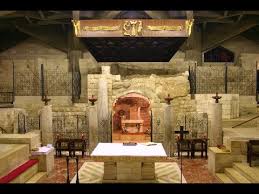Culture always influences Catholicism in various ways. In the sentimental culture of the United States, to take a sore case in point, people frequently respond to situations based on feeling rather than reason or thought. So now in American Catholicism, for example, if the priest starts Mass with all kinds of greetings followed by, “The Lord be with you,” he is not working with the full meaning of the words of the Mass. The spiritual profundity of those words vastly transcends that of “Welcome. Thank you for coming,” or “Happy New Year.” Nor is the priest helping his people to grasp the wonder of these words – of being in Christ. He is beginning, instead, with sentimental words that have no spiritual depth.
The depth only comes from what we know from divine revelation. In the greeting, the priest is praying that the Spirit of God act dynamically in this particular gathering of the community, come together, here and today, to offer worship. This is breathtaking and has nothing to do with what might be going on in the culture. God is acting right here and now, in this particular church, to redeem his people and continue his transformation of the world.
Sentimentalism often moves some Catholics to vote for a party with policies that are anti-Catholic and anti-human. Perhaps it was owing to feelings or habit or convenience or some kind of superficial identification with a candidate. Again, the perspective Catholic voters actually need comes from divine revelation. Correcting the imbalance between reason and feelings involves consciously bringing political decisions back under the umbrella of Catholic moral theology – real concepts capturing real truths.

Having your emotions stroked rather than climbing the ladder of human functioning and bringing reason to bear on serious matters might be acceptable to some of us. But we were all given the powers in our souls to live an authentic life. Preaching and teaching have to bring that out.
Prudence is one of the main signs of authenticity. It is called a virtue, not in the sense that it is only for the 1 percent who want to be saints. It is for all who want to operate in an authentically human way. The Catholic Encyclopedia defines prudence as “an intellectual habit enabling us to see in any given juncture of human affairs what is virtuous and what is not, and how to come at the one and avoid the other. It is to be observed that prudence, whilst possessing in some sort an empire over all the moral virtues, itself aims to perfect not the will but the intellect in its practical decisions.”
Prudence points us to making an effort to find information and sound analysis about what good is to be done in a particular situation – and how to do it. This takes humility and, frankly, some heavy lifting. Humility because we often do not know what we need to know. And heavy lifting because we have to work to find it out. Prudence leads to genuine human action, which is what we aspire to when we participate in liturgy as much as in daily life.
Pope emeritus Benedict XVI, when he was still only a humble professor once said: “man does not come to himself if he simply abandons himself to his natural inclination. To become truly a man, he must oppose this inclination; he must turn around: even the waters of his nature do not climb upward of their own accord.” This new depth of human being develops as God gives us the gift of our true selves.
Sentimentalism interferes with the clergy’s ability to act. Hearing that: “We like Fr. X” is gratifying, but is he helping us to develop as Christians? Or does he leave us undisturbed and unchallenged? Do I have to go and ask him to act like a priest? The long history of professionalizing the priesthood has cut out most people’s interactions with the priest. Yet the priest is the most highly and expensively trained Christian around.
The whole point of the clergy is to lead the community to deeper faith. In contrast, sentimentalizing the clergy allows them to go to their happy place, the office, instead of being out where people are interacting with them for several hours a day to learn to follow Christ better.
One last point about the liturgy: Participating in liturgy presumes an intellectual response. The emotions the liturgy arouses may be good in their way. But we first need to know how we are part of the great history of salvation. We need to know that Jesus Christ is speaking as the Word in the readings and the homily, that he is present in what looks to be bread and wine. And to know, when we go home, that we have participated in the sanctifying of the world.
Our emotions should find a place in the liturgy, but they are at their best when they are tied to grasping the intellectual wonder of what the Spirit of God is doing. The liturgy is a set of very simple actions that have vast spiritual implications. But we will see that only if we bring ourselves completely – body, mind, spirit – to the table.














